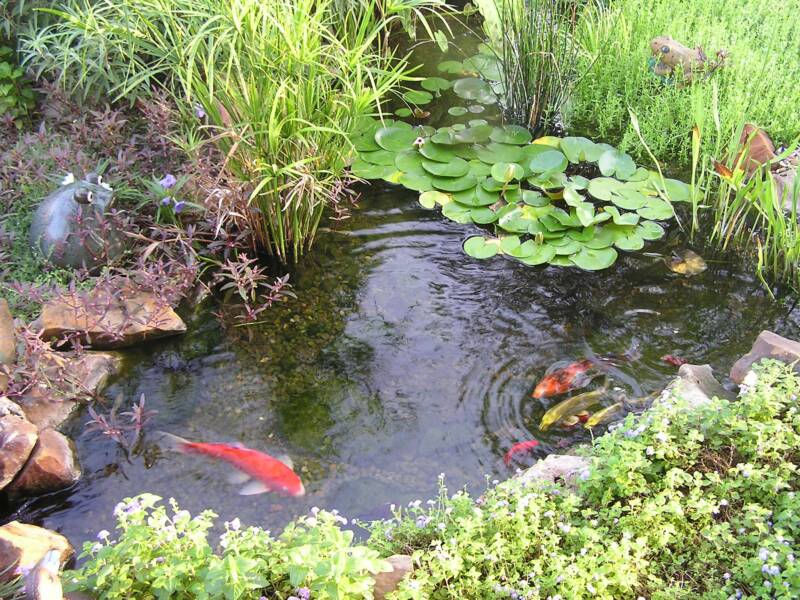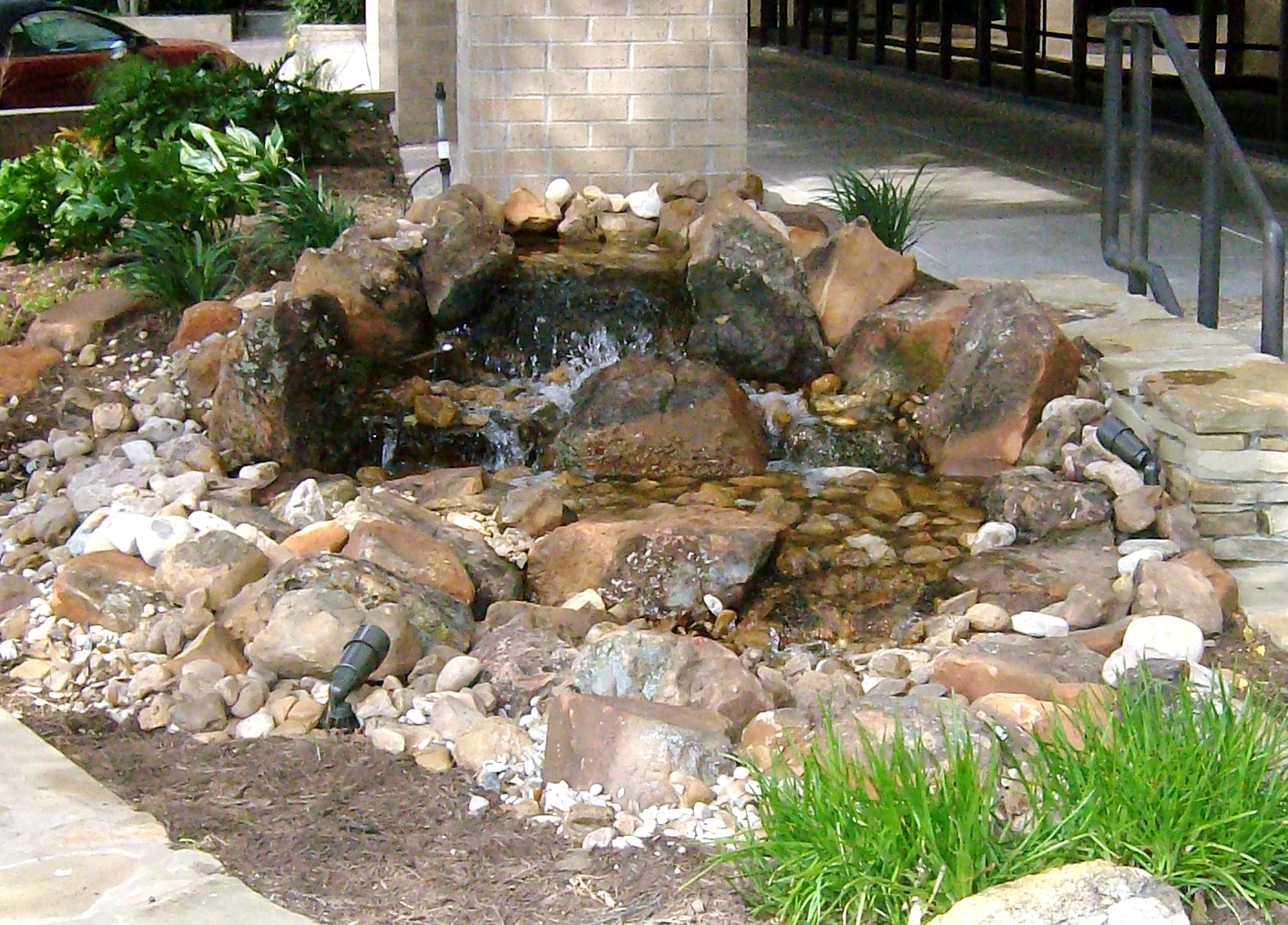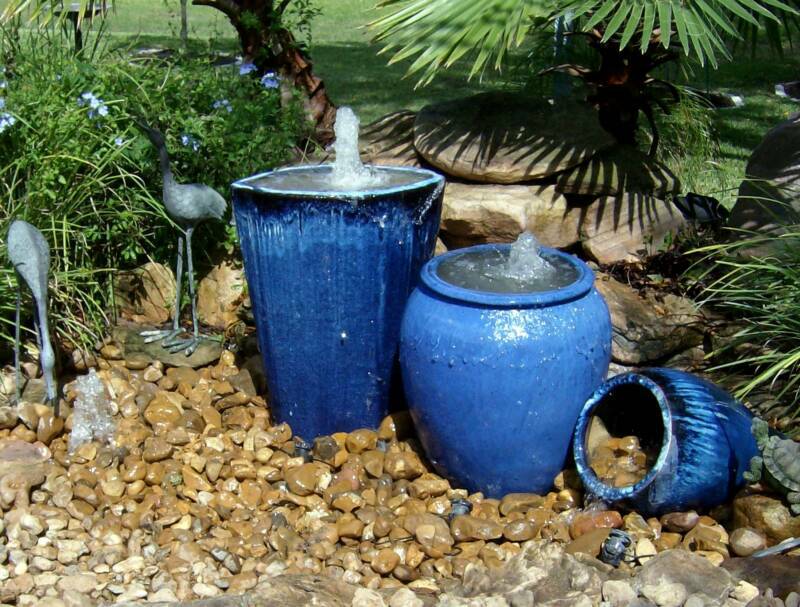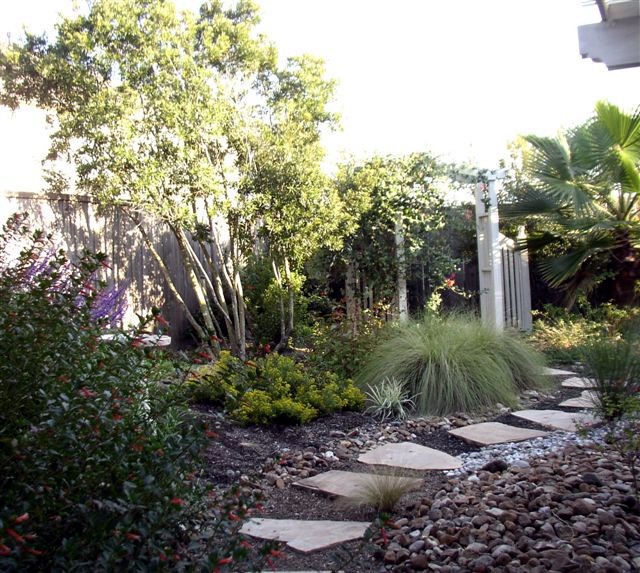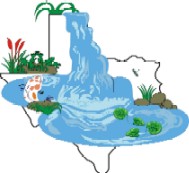


Rainwater Harvesting
Organic Ecosystem Ponds
Pondless Waterfalls
Urn and Fountain Features
Water-Wise Landscapes
Frequently Asked Questions
Just what is a water garden?
A water garden is better known as a pond. Now, don't think it's like one of those cement, mucky, dirty-looking green fish ponds you may have seen before. A water garden is a living ecological entity. It contains a waterfall, rocks, water lilies, aquatic vegetation, underwater lights, and of course, beautiful colorful fish. The water is crystal clear and you can see all the way to the bottom.
Ecosystem Ponds have made living the water gardening lifestyle easy and easy to understand. Instead of high-maintenance, chemically-regulated sterile fish pools, water gardens rely on a naturally balanced ecosystem to stay clean and healthy all year round. A balance is achieved between the plants, fish, and naturally beneficial bacteria in the pond. These pond systems work with nature, not against her to keep your pond water crystal clear throughout the year with minimum effort required on your part.
What are the benefits of owning a water garden?
Having a water garden professionally installed by a Certified Aquascape Contractor is one of the best investments you can make for both the value of your home and your lifestyle. A backyard pond gives you your own private place to relax and unwind at the end of the day. Water features are soothing, tranqil, and a haven of rest. The sound of water splashing gently over the stones soothes away the stresses of the day and leaves you feeling completely refreshed. I often start my day by reading the morning paper while drinking juice beside my pond. It's a great place to collect my thoughts and get ready to take on the day.
Water gardens are also a great way to help re-connect your family with nature. Interacting with a pond, they'll see the circle of life played out before their eyes. A water garden will attract its own circle of life including frogs, dragonflies, birds, and butterflies. Frog eggs appear overnight as if by magic. Watch them hatch into tiny tadpoles and grow bigger and bigger, finally sprouting legs and leaving the pond to eat insects in your garden. Birds frequently nest near water sources. Dragonflies appear in the most startling array of colors, eating mosquitoes and laying their eggs on the plants in the pond. If you're paying close attention, you'll see the dragonfly nymphs crawl up a cattail stalk, shed its skin, open its wings and fly away for the first time ever. Even the fish will breed in a water garden, adding to the color and variety of life supported by your living ecosystem pond.
If you're into entertaining, a water garden is a great gathering place for your friends and family. Your guests will find the pond irresistable with its intricate waterfalls and flowing streams. The fish shine brilliantly in the underwater lights as they glide gracefully in and out of the submerged aquatic plants. Your backyard will be the talk of the town and you'll probably find your friends making up excuses to visit your home. One of our customers awakes every once in a while to find his neighbors quietly sipping coffee on his back porch, watching his fish.
A properly constructed low-maintenance water feature will also add value to your home. Elaine Garner of Keller-Williams Realty in Lakeway had two of our ponds. In a recent article about ponds raising real estate values she said, "I sold my house specifically because it had a pond......Everyone wants tranquility and privacy, and ponds provide both. It gives the feeling of a protected, secure atmosphere."
How much time will I spend maintaining my water garden?
Water gardens, compared to traditional chemically-dependent ponds, are extremely low-maintenance. There are no chemicals to buy or water test kits to master. The amount of time spent on regular maintenance will vary from pond to pond. The different parts of the ecosystem-plants, fish, bacteria-work together constantly to keep your water garden balanced and healthy, leaving you free to relax and enjoy. The BIOFALLS(R) filter is designed to be cleaned only once or twice a year. Ponds located near lots of trees will need their skimmer emptied more often in leaf-drop season than ponds in a tree-free environment, such as a courtyard. Other than emptying the skimmer, you'll only have to periodically add a little bacteria to keep the pond clear and sparkling no matter what season it is. The addition of an Ionizer will completely eliminate string algae from most ponds!
I'm afraid the filters will make my yard ugly. Where can we hide them?
We are overwhelmingly concerned with making our water features look as if Mother Nature carved them over hundreds of years. This would be hard to accomplish if we had to place some miniature swimming pool filters somewhere in your backyard. The sight of bulky cannisters and the whine of the pumps would be a constant distraction from the little piece of nature we're trying to create for you. That's one reason that we install the Aquascape Ecosystem Pond for our clients. It is the top-of-the-line filtration system for your pond and the system is designed to be totally hidden. This way, we can construct the most natural looking water feature for you. The skimmer is buried in the ground along the pond's edge where it constantly sweeps the surface free of leaves and other wind-blown debris. It's covered by a lid that looks like a piece of natural stone. We can even construct a negative-edge pond that eliminates the skimmer entirely and drastically reduces maintenance. The BIOFALLS(R) biological filter is actually housed inside the waterfall and surrounded by a natural berm of soil. You never see it! A shelf inside the edge of the BIOFALLS(R) allows us to place rocks all the way around so you don't see anything artificial.
What about mosquitoes? I don't want to get West Nile!
Mosquitoes lay their eggs in still, stagnant water. Our ponds feature constantly moving water, so they are not good breeding grounds for mosquitoes. Any mosquito eggs or larvae in the pond will soon be eaten by the fish or drowned in the skimmer. The skimmer or negative edge feature is constantly pulling the surface layer of the pond into itself and mosquito larvae would find it impossible to resist this pull. In addition, natural water features attract a variety of frogs, toads, and dragonflies which feast on the mosquitoes that are already in your area. Your pond will not become a mosquito factory and in fact, may help to reduce mosquito populations already in the area.
How does the ecosystem work?
To put it simply, the ecosystem works like this: Natural beneficial bacteria colonies take up residence in the biological filter and on the rocks and gravel of the pond. Because there are nutrients available in the water, a thin layer of algae grows on the rocks. The fish eat the algae in the pond, keeping it clean and consuming the nutrients. Their waste contains ammonia, which is toxic to the fish at high enough levels, as well as unabsorbed nutrients. This ammonia is converted by the bacteria into ammonium nitrate, which is plant fertilizer. The aquatic plants, which are removed from their pots and planted directly in the gravel substrate of the pond or bog, are forced to take the ammonium nitrate they need directly from the water itself, cleansing the water of excess nutrients that could otherwise cause an algae bloom. The plants, fish, and bacteria achieve a balance among themselves that leaves your water garden crystal clear and nearly maintenance-free. Of course the pump is also a necessary part of the overall system as well. If any of these ingredients are missing, the pond will be much harder to balance and therefore to maintain. Click here for more information about the ProPond Ecosystem.
What are the steps involved with constructing my water garden?
The first step in the process is calling us to schedule a design consultation with the owner of our company. An information packet will be mailed to you at that time including a DVD that will help answer questions you may have as well as present many different water features to give you some ideas. We charge for our design consultations ($125 in the Austin area) because we don't charge our customers for time we spend with other people. Your consultation fee will be deducted from the price of your project if you choose to have us install for you. At your consultation, we will need 1) a drawing of the site plan 2) your ideas for your project and 3) your budget for the project. We ask for the budget because we can build a $5,000 pond or a $50,000 pond in most backyards. It doesn't make sense to spend time drawing up a pond project that's way over your budget or compromise on a smaller, more limited feature when you are willing to spend the money to make it the biggest and best it can be. Everyone has a different idea of what they want and what is an acceptable price for that product.
After your initial design consultion, you will know the size and shape of your water garden as it will be marked on the ground during the consultation itself. Your bid will follow shortly so you can see just what it will cost to complete your project. We require a signed contract and deposit to order materials and schedule your job. Remember, the cost of the consultation is deducted from your final payment.
When the crew arrives, we will first re-mark the pond area. Then we assemble and install the BIOFALLS filter. This will set the place that your water will begin its return to the pond via the waterfall. We install the plumbing and begin excavating the pond, using the soil that we remove to build a natural-looking berm around the BIOFALLS. The pond will be dug in 2 or more levels to provide growing areas for plants that require different depths of water in which to thrive and to provide deep areas for the fish to hide in case of predators. We excavate the hole for the skimmer as the pond is being dug. When excavation is complete, we install the skimmer in the ground, carefully checking its level. The Aquascape skimmer features an automatic overflow valve in case of heavy rain. Once the skimmer is set, we install an fabric underlayment to help protect the 45 mil fish-safe EPDM liner, which goes in next. With the liner in, we now begin setting small boulders on the shelves of the pond until the vertical surfaces are fully rocked in. One person breaks off to attach the liner to the skimmer. Now is the time that we install underwater lights, aiming them carefully, and locking them between the small boulders. Gravel is then spread onto the horizontal surfaces of the pond, covering all the light cables and all the remaining liner. We rinse the pond and start filling it.
While the pond is filling, we start working on the waterfall/stream area, working our way from the pond's edge back toward the BIOFALLS. This is the time of day that we get really creative and artistic as we attempt to sculpt moving water that isn't there yet. With all our experience, we have a pretty good idea what the water will do when turned on. When the waterfall is turned on, we trim all excess liner to leave the pond's edge looking neat. We tweak the waterfall, making any changes we need to make the water do what we want. Then we apply edge treatment to the pond, making sure that it doesn't look the same all the way around. This makes the pond look more natural. We finish building the berm and a retaining wall behind it, if necessary. The lights are hooked up to the transformer and tested. After a brief instructional from our Pond Guy, you will be presented with a supply of bacteria to start your pond's ecosystem right. An Owner's Manual packet will be mailed to you.
How big should I make my pond?
The size of your pond is determined by several factors. The first two are the size of your yard and the size of your budget. We can build water features as small as 6'x8' or as large as an acre or more, depending on your needs. An 11'x16' pond would be too large for a small courtyard, but would be lost in a one-acre backyard. From our experience, we suggest building as large a pond as your budget will allow. The only complaint we ever hear from our customers is, "I wish I would have made it bigger!" One of our clients even had us come in only two months after we had installed an 11'x16' pond and double it to a 22'x16', adding a second waterfall in the process. It would have been much cheaper for her to have just started with the big pond. Go into it with the attitude that you're going to love it. If we build it for you, we'll make sure that you do!
If you're looking at your overall landscape budget and don't think you can squeeze a water feature into the scheme of things, then by all means, do your landscape in stages. Start with the pond, which will add instant beauty to the yard this year. Next year you can have a walkway, patio, or gazebo installed next to it or finish out some planting. This way you can have a spectacular yard in the long run without burning through your entire landscape budget. You don't want to pay for landscaping and then have to rip it out to install the pond later. Start with the pond. Then you'll have a centerpiece to frame the rest of the landscaping around.
The most popular size pond we install is around 10'x15' and that's a great size to start with if you have the space and have never been into water gardening. This size pond fits well into most backyards. Ponds this size and larger are easier to keep in balance because small changes in the environment won't affect them as much as a tiny pond. If you've been a water gardener in the past, you'll probably want to start with a larger pond if you have the room. One way to make a standard-size water feature appear larger is to add a stream to the pond. This increases the amount of "shore space" for you to interact with your water feature. The more shore space there is, the larger the water feature will seem in your landscape.
How much does a water garden cost?
Like any custom creation, the cost of a water feature varies. We install the Aquascape Ecosystem Pond and follow their installation practices.. It may cost a little more up front, but it's the best pond system on the market. Higher quality materials always cost more than lower quality ones. We know from our over fourteen years experience installing and maintaining this system that it works, it lasts, and we can stand behind it. Heck, we'll stand right in the middle of it! We use this system for most all of our pond projects. For ponds larger than about 15'x15', we use a constructed wetlands, or bog filter in place of the BIOFALLS biological filter. The all-natural Aquascape filtration system in its various combinations is the best pond system available for ponds from 6'x8' up to an acre or larger. It's fully flexible, allowing us to add as many waterfall and stream combinations as the laws of hydraulics will allow.
Each water feature is a custom creation, as imagined by the mind of the professional pond artist according to your wishes as set out at your design consultation. Therefore we can't quote exact prices for your particular water feature. We can, however give you reasonable estimates that should be pretty close to a starting cost. The following numbers are for ponds with a single waterfall directly on the pond's edge. Ponds are from 18-24" deep. Remember, water features look better if you set the waterfall off of the pond's edge 6 feet or more.
The first factor in the cost is the pond components necessary to complete your one-of-a-kind, custom pond. These include filters, pumps, plumbing, liner, LED lighting, etc. The stone is also a factor in the price of your water feature. The larger the pond, the more stone we'll need to build the feature correctly with stone covering all the liner. If we build a big pond out of little rocks, the end result won't look to scale, so we use bigger boulders on bigger ponds. The labor charge is the final factor in the cost of the water feature. Of course, the bigger the water feature, the longer it will take to excavate and set all the stones.
POND SIZE














 FROM
FROM
8'x11'
















 $8,500.00
$8,500.00

11'x16'
















 $12,000.00
$12,000.00

16'x21'















 $21,0000.00
$21,0000.00


All water features will require on-site custom bids.
What are the parts that will be installed and what is their function?
Each component in your all-natural pond system is a necessary part of the water feature. The Biofalls is an upflow biological filter. It is a chamber to house the bacteria that keep your pond water clear and healthy, but it also provides a base for building our waterfalls. The Biofalls can be sunk into the ground to start a stream or to provide a shorter waterfall. The skimmer is a chamber that's installed in the ground alongside your pond and attached with a water-tight seal. Its main functions are to house the pump and to help keep your pond free of windblown debris by constantly pulling the top layer of the pond in and depositing the leaves and other debris in an easy-to-empty basket. The skimmer also protects the pump from clogging by providing the debris basket PLUS another filter mat that the water must pass through before it reaches the pump. The back of the skimmer provides an overflow valve that allows excess water from rain to pass easily out of the pond, keeping it from overflowing.
An alternative to having to empty the skimmer is by having your pond installed as a zero-edge feature. In these cases, we borrow the pump vault and AquaBlox from our pondless water features and create a pond with no skimmer. A zero, or negative-edge pond features a section of the pond's perimeter where water flows over a waterfall and appears to simply disappear into a bed of gravel. This option results in less maintenance for the pond owner and a more natural look.
Different pumps are available for use in your water feature. These pumps can range from 1500gph and 50,000gph or more. The correct pump will be determined for your job. These pumps are warranted for two years. We use flexible PVC pipe to connect the pump in the skimmer to the BIOFALLS. It's faster and easier to use than rigid PVC, plus its flexibility allows it to survive freeze/thaw cycles without cracking. A one-way check valve is used to keep water in the piping and BIOFALLS in the event of power failure. This protects the living bacteria in the BIOFALLS. Underwater lights are connected to a low-voltage lighting transformer which features a photocell to automatically turn the lights on and off for you.
We use a needle-punched polyethelyne fabric underlayment to help protect the underside of the liner. Our liner is a 45mil thick EPDM liner that's completely flexible and is guaranteed fish-safe. Its flexiblity allows us to create water features of any size or shape. This liner is so tough that it comes with a twenty-year warranty.
We use only natural stone in our water features. The stone for your pond will be hand-picked by our designer at the stone yard, delivered directly to the jobsite, and placed in the pond. We use a mixture of gravel and smaller stone to cover the liner and help lock the small boulders into place. The rocks and gravel also provide lots of suitable surface area for beneficial bacteria to colonize, reducing muck build-up and giving you a cleaner pond system with less maintenance. If we need to bring in extra soil for your project, it will be a high-quality landscaper's mix which will help you easily establish the surrounding landscape.
Will my kids be safe around a pond?
Kids love water features. They will sit for hours fascinated watching the fish, frogs, birds and insects interact at the pond's edge. A stream becomes a raging river for G.I. Joes to traverse. Your kids can enjoy camping out next to a waterfall without leaving the back yard. It's perfectly OK to let your kids play in the pond and stream. They can't do any real damage as long as they don't puncture the liner with something sharp! Even your dogs are amazed watching the fish swimming in the clear water. It won't even hurt the pond if they get in to take a swim. They may make a mess of your plants, though. But plants will grow back.
Of course toddlers should be supervised around any body of water. That's a given. On the other hand, it's important to note that our ponds are built with different shelves, or levels, at different heights. The first shelf is usually dug 6-8 inches deep. So if a child were to fall into the water feature, they would only be in 6-8 inches of water and could easily climb out. The other shelves area also stepped down to a maximum depth of about 2 feet. Most children could climb up the shelves like a staircase with ease, even from the deepest part of the pond.
What about fish? I've heard that keeping fish requires a lot of time.
Having fish in your pond will actually decrease, rather than increase your maintenance time by doing their part to keep the ecosystem balanced. You do not even need to feed the fish. They will happily graze on the thin film of algae that coats the rocks and forage for organic debris that makes it to the pond bottom. You see, Koi are naturally bottom-feeding scavenger fish. That's why they have those little barbs by their mouths. They use these barbs to help feel around and locate organic material on the bottom. Koi and other pond fish will find all the nutrients they need just by scavenging the rocks and gravel. And your pond will be cleaner because of it.
The ammonia in fish waste is necessary for the biological filtration to function properly. The bacteria in the filters compete directly with the algae for the same nutrients, so the stronger your bacteria colonies, the cleaner and clearer your water will stay. In addition, fish waste provides essential nutrients to the plants in the pond, meaning that you never have to fertilize them either! So, simply by having a few fish in your pond, your pond stays cleaner, the filtration is strengthened, and your aquatic plants get fertilized without you lifting a finger! If you're understanding this, then you're starting to see how a balanced pond system works on its own to keep itself nearly maintenance-free.
Won't predators eat my beautiful fish?
Land-based predators, such as cats or raccoons are usually not a problem. They will not swim for a meal and unless the fish come over to them and volunteer, they will not have an easy time catching them. The shelved pond provides a deep area for the fish to go to if they feel a threat. The only problematic predator that may pose a risk to the fish is the heron. They can walk into any part of the pond and just wait till a meal swims by. There are several ways to counter this particular threat. Tunnels and caves can be fashioned and installed in the pond as it is being constructed and disguised with rock. These give your fish an even more secure area to hide if they feel threatened and they blend into the pond so well that nobody but the fish know they're there. You can also purchase a motion-controlled sprinker device which lets loose a three second burst of water if anything moves in its range of motion. Less than 5% of our ponds have experienced any problems with herons, so they shouldn't be an overwhelming concern for you.
I have a dog. Won't he tear up the pond getting in and out of the water?
Dogs love water gardens, and because of the way ours are built, your dog shouldn't have any problem getting in and out of the pond without any trouble. It won't cause a problem with the fish or the ecosystem. You may have to replace a rock here or there from time to time, but the pond system won't be damaged at all. In fact one of our customers had her pond installed specifically so that her dogs would have a place to cool off in our hot Texas summers. She has five dogs, some as big as a German Shepherd that have the run of the yard. She was deciding between getting a pool or a pond and she chose a pond because it's cheaper, easier to maintain, and is something she can enjoy all year round. Now she likes to have a glass of wine beside the pond when she gets home from work each day.
What about streams? I've always wanted a gurgling stream winding through my back yard!
The best place for you to interact with your water feature is at the edge, where the water meets the land. We call this area 'shore space'. The more shore space your water feature has, the more opportunities you'll have for interaction with your pond. Streams are a great way to add this shore space without creating a monster-big pond. This allows you to increase the overall size of your water feature without increasing the cost proportionately. An 11'x16' pond with a 30-foot stream looks a lot larger than the same pond without the stream.
Adding a stream to your pond also allows us the ability to create drops, deep slow-moving areas, and shallow areas where the water speeds up and ripples over the gravel in the stream. Big boulders can be set in the stream which force the water to pool up to go around. Streams also provide filtration and oxygen to the water garden. The stream liner can be seamed to the pond liner to provide a 'deep stream' area that the fish can swim into. You may want to put a small bridge over this area so you can hang your feet off and feel the fish tickle your toes!
Can I have more than one waterfall?
By utilzing the fully-customizable ecosystem pond model, we can create as many waterfalls and streams per water feature as you want. You may choose to put a waterfall at the pond and another one across the yard, flowing through a stream thirty or forty feet into the pond. We can even make waterfalls, streams, and other types of water features without ponds where the water just seems to disappear into a bed of gravel. Just about anything you dream up, we can do. At your consultation, your designer can discuss possible options for your water feature's design, so have some ideas ready and don't be afraid to bring them up. We want to create the slice of paradise that YOU want. It's not about us demonstrating our pond-building skills. It's about putting together YOUR vision for your backyard getaway. If you aren't sure what you want, we can certainly suggest our ideas for the space based on our many years of experience.
I don't have room for a pond, but I love the sound of moving water in my yard. Can I have a waterfall without a pond?
OR
I'd like a waterfall in my front yard to build a landscape around, but I don't want the liabilities of kids falling in the pond. What can I do?
Pondless waterfalls are definitely the way to go when you want the look and sound of a natural waterfall without the pond itself. Your waterfall will still look nature created it, just like the ones we build on our water gardens. But at the bottom of the waterfall or the end of the stream, the water simply seems to disappear into a bed of gravel.There's no bacteria to add and zero maintenance, other than topping off the water level every now and then. Best of all, there's no chance of a child stepping into your front yard water feature. Plus, since a pond-less waterfall doesn't need biological filtration, you can turn it on or off whenever you want to.
Another great thing about pondless waterfalls and other pondless features is that they can be combined with our RainXChange rainwater harvesting sytem to help you save on your water bill!
Roll your mouse over the photo to see this yard transformed.

